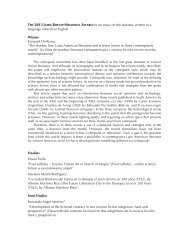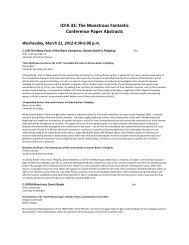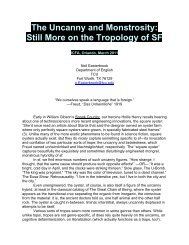<strong>Fantastic</strong> Suicide: Reading the Uncanny in Shion Sono’s Suicide Club, Human Bodies as Corpses and MeatKathryn DunlapUniversity of Central Florida<strong>The</strong> issue of suicide in Japan is a complex one with a long history and a variety of cultural associations that are often overly simplified inWestern examinations of the issue. Recent trends in the phenomena and the rapid increase in the rate of Japanese suicide starting in the 90sand continuing into the 2000s has lead to growing public concern and an increase in social and governmental intervention on the issue. Despitepreventative steps, Japan still has the highest suicide rate of any G8 nation and there is a growing trend of Internet suicide pacts among theyouth of Japan. This paper will examine Shion Sono’s award winning film Suicide Club as a surrealist horror genre commentary on the culturalunease of the Japanese and how the sudden increase in suicide rates has impacted Japanese culture by introducing elements of Freud’suncanny into the narrative. <strong>The</strong> fear of suspected suicide pacts creates an uneasy distinction between those who are alive and those who,having already made a pact, are only animate corpses. In addition, several key elements blur the distinction between human flesh and meatcreating cognitive dissonance in the uncomfortable familiar. This paper will also examine the ways in which Kristeva’s abjection operates on thesuicides within the film both before and after their deaths. Japan’s current suicide crisis is linked significantly with Japan’s disaffected youth,who experience abjection from a more traditional Japanese culture and after their deaths, their bodies become abject within the culture thatviews them as uncanny objects.Tabehodai (All You Can Eat): Kuchisake Onna and the Female Maw in Japanese Folk CultureNicholas WareUniversity of Central FloridaJapan is a country with a rich history of folklore yokai (monsters). Yokai take numerous forms and exist in all contexts--rural and urban, ancientand modern, friend and foe--but no yokai has been as prominent in the last 30 years as kuchisake onna (slit-mouthed woman). This urbanlegend has its roots in the late 1970s, and tellings vary. <strong>The</strong> salient details always include a beautiful, fit woman whose mouth is covered (oftenwith a surgical mask). After asking her victim, “Am I pretty?” the cover comes off, revealing an ear-to-ear mouth that contains numerous razorsharpteeth. <strong>The</strong> kuchisake onna is the most popular and recent example of a Japanese folk monster whose femininity is weaponized throughconsumption. It can be linked to other examples of female Japanese monsters (onibaba, the Dojoji snake woman, and futakuchi onna), all ofwhom are notable for their unique habits of consumption or their gaping maws. <strong>The</strong>se monsters stretch back into Japan’s past, but theiremergence in post-war Japanese popular culture (chiefly manga and film) show their continued connection with multiple anxieties of Japaneseliving, such as feminist revenge on the patriarchy, contagion, urban alienation, and the beauty myth. <strong>The</strong>se anxieties will be analyzed through acareful study of these monsters, both in their folkloric form and their popular culture form. <strong>The</strong> popular texts that this paper will focus on arethe films Carved (2007), Onibaba (1964), and <strong>The</strong> Slit-Mouthed Woman (2005) as well as the manga Hanako to Guuwa no Tera (2004) andGeGeGe no Kitaro (1959 – 1969). <strong>The</strong> scholarship will be situated chiefly through the work of Michael Dylan Foster, Barbara Creed, AdamLowenstein, and Kazuhiko Komatsu. Through textual and cultural analysis, this paper will set up kuchisake onna as the totem creature of postwarpatriarchal-industrial culture in Japan.9. (SF) Gender and Feminism in Science Fiction OakChair: Kathryn AllanIndependent ScholarNarrative Structure in (Some) Feminist SFRitch CalvinSUNY, Stony BrookPerhaps because it has often been said that science fiction as literature is a medium of escape, a type of narrative that lends itself to therepresentation of ideas, science fiction novels have often taken the form of straight-forward, linear narratives. For the purposes of this essay, Ipropose to examine Marge Piercy’s Woman on the Edge of Time (1976), Margaret Atwood’s Handmaid’s Tale (1986), and Laura Bynum’sVeracity (2010). In each of these novels, the first-person narrative unfolds in a manner that calls into question the reliability of the narrator—and, thereby, the veracity of the events themselves—and the position of the reader as knower. Because of the fragmented, fragmentary, andnon-linear structures of the novels, the reader, as the women in the novels themselves, are placed in a position of epistemological uncertainty.Furthermore, the first two novels, by means of their codices, further undermine any epistemological certainty the reader might expect from ascience fiction novel.“It’s Not That Straightforward”: Ambivalent Feminism in Lesley Hauge’s NomanslandAubri PlourdeHollins UniversityIt seems painfully obvious to discuss gender in a text written about a post-disaster, all-female community like the one presented in LesleyHauge’s Nomansland. Nonetheless, despite the book’s domination by female characters all living in uniformed synchronicity, it presents severaldifferent presentations of femininity. At first, the text seems to present the dangers of both adolescence and feminism gone wrong. In fact, in areview of Nomansland, Kate Quealy-Gainer claims, “the story’s underlying assumptions about female-ness and its necessary attachment tobeauty tempers its feminist punch” (435). However, a reading of the underlying implications represented by the polarity of Laing and Ms.Windsor and the resulting variations in female characters makes the story’s linking of female-ness and beauty only a single facet in a morecomplex structure. In Nomansland, Laing and Ms. Windsor act as foils competing for Keller’s attention, both of which present damaging imagesof feminism. However, Keller’s ambivalence toward both leaders coupled with the remaining community of individualized women between the
poles of Ms. Windsor and Laing abjures traditional or simple feminist readings. Instead, the neo-archetypes of the women in the wake of Laingand Ms. Windsor’s tension create a more nuanced and complex view of womanhood.Love (or Not) in Androgynous Spaces: Binaries and Identities in “Day Million,” “Closer,” and “Androgynous”Mary LongFlorida Atlantic UniversityStrict binary systems don’t just maintain the separation between mind/body, male/female, and natural/technical; strict binaries confuse theprocess of identity construction because identities are more complex than opposing sets of 1s and 0s or XXs and XYs. Identities are asperformative as Judith Butler says gender is. ln “Closer,” by Greg Egan, and “Day Million,” by Frederik Pohl, strict binaries reinforce traditionalmale/female performances, even though some traditional boundary lines have been blurred. In the song “Androgynous,” by <strong>The</strong>Replacements, androgyny is positioned as a space to refute the male/female binary. Out of these works, the most successful relationship is theone based on symbiotic identity constructions that work together to challenge an oppressive dominant binary system. Using gender theory byJudith Butler and touching on transgender findings by Dr. Az Hakeem, the relationships between: Sian and Michael of “Closer”; Don and Doraof “Day Million”; and Dick and Jane of “Androgynous” can be analyzed in lieu of their attempts at deconstructing gender binaries andconstructing relationships based on non-traditional gender identities. Androgyny, while not a perfect solution to a binary gender system, offersa way to play with identity and reorder potentially limiting relationship roles. In “Day Million” and “Closer,” couples are offered technologicalinnovations that allow extremely androgynous behavior; however, this behavior is not necessarily successful in refuting binary coercion due tothe relocation of gender from body to mind in each work. Ultimately, the kinds of repetitions enacted in a song like “Androgynous” and theexploration of the short-comings of gender reconfigurations that are located in body only like those in “Closer” and “Day Million” add to theways in which we see how binary gender systems can negatively impact identity and relationship constructions.11. (FTV) Posthumanism and Monstrosity PalmChair: Susan A, GeorgeUniversity of California, MercedIt's Not the Monsters Who Scare Us Anymore: Stitching and Cutting to Posthumanism in Martyrs and <strong>The</strong> Human Centipede (First Sequence)Tiffany FrostFlorida Atlantic University<strong>The</strong> incorporation of medical discourse into horror films often functions to relocate healing, sickness, and death to a space that is subverted tofocus on mutilating, infecting, and playing with the borders of human and nonhuman existence. In two popular horror films, Tom Six’s <strong>The</strong>Human Centipede and Pascal Laugier’s Martyrs, the lead characters are subjected to surgical mutilation by a character who has the culturalpower and physical environment to create a living experiment as a testament to humanity’s intelligence and possible metaphysicaltranscendence. In both films, the objects of vivisection are young people who appear as relatively average. One way to approach the monstrousHuman Centipede that is made by sewing three bodies together and connecting the mouth to the anus of the person in front of them would beto dismiss this film as unnecessarily violent, gratuitous, and, thus, filth. And one way to consider a film like Martyrs might be to engage in howdemeaning the film is to the female human body. Another avenue that is worth exploring is how coprophagia, physical torture, and thesubversion of medical procedures are situated in these films as tools of the ideology of monstrous humanism that has been so vehementlychallenged by the scholarship of Jacques Derrida, Donna Haraway, and Cary Wolfe. This essay considers how these films negotiate the bordersof humanity, animality, and monstrosity by the silencing of the human voice, the consumption of feces, victim suicide, and the distortion ofnonhuman animal voices and bodies within the scope of posthumanism.You're So Cute, You Could Just Eat Me Up: Cuteness, Monstrosity and Posthuman SubjectivityAaron KashtanGeorgia TechThis paper examines the parallel operation of cuteness and monstrosity in contemporary American and Japanese popular culture, using HayaoMiyazai's My Neighbor Totoro (1989) and Spirited Away (2001) and Pete Docter's Monsters, Inc. as case studies. For Sianne Ngai, the cute objectevokes destructive impulses: “the cute object is as often intended to excite a consumer's sadistic desires for mastery and control as much as hisor her desire to cuddle.” This suggests that monsters can't be cute (their threatening, destructive impulses are directed toward us rather thanvice versa) and that cute objects can't be monstrous (they lack the necessary threateningness). Yet Ngai observes that “it is possible for cuteobjects to look helpless and aggressive at the same time.” Conversely, cute creatures labeled as monsters appear with surprising frequency inpopular culture. In this paper I attempt a preliminary explanation of these paradoxes by observing that cute things and monsters both occupy aposition of alterity relative to the human subject. <strong>The</strong> cute object affects us by its position of inferiority and vulnerability relative to ourselves;the more an object resembles the adult, rational human subject, the less cute it gets. Similarly, the monster affects us by its difference from thehuman. <strong>The</strong> figure of the cute monster is therefore a natural combination of two categories that are defined by their disturbing difference fromthe human. This makes the cute monster an intriguing figure for the posthuman subject – that which we recognize as having subjectiveinteriority, but which we cannot reduce to a human subject position. While Pixar's film tries to defuse the subversive potential of the cutemonster, Miyazaki's films embrace the power of the cute monster to question the traditional understanding of the human as the privilegedform of subjectivity.
- Page 4 and 5: 5. (F) Wondrous Bodies of the Gende
- Page 8: Viral Posthumanism: Boundaries and
- Page 11 and 12: The Concept of Soul Divisibility in
- Page 13 and 14: Thursday, March 22, 2012 10:30 a.m.
- Page 15 and 16: 21. (CYA) Terrifying Futures: Post-
- Page 17 and 18: 23. (FTV/H) Now I’m Feelin’ Zom
- Page 19 and 20: Fight Club: Amalgam of the Horrific
- Page 21 and 22: Taking the Monsters out of the Clos
- Page 23 and 24: Kaspar J. SaxenaIndependent Scholar
- Page 25 and 26: 44. (CYA) The Monstrosity of Teenag
- Page 27 and 28: 46. (FTV/SF) Monstrous Spin-offs: T
- Page 29 and 30: 49. (F) Aspects of Miéville Captiv
- Page 31 and 32: 53. (SF) War and Crisis in 1940s an
- Page 33 and 34: Abuse of Power: An Evolutionary Res
- Page 35 and 36: Disappearing Natives: The Colonized
- Page 37 and 38: 60. (H/IF) Ancient and Medieval Mon
- Page 39 and 40: 62. (F) The Works of Tolkien Captiv
- Page 41 and 42: 67. (SF) Imperial and Postcolonial
- Page 43 and 44: Beheading the Gorgon: Beautifying C
- Page 45 and 46: 71. (VPA) Monstrous Music MagnoliaC
- Page 47 and 48: 73. (F/IF) Portraying New Worlds Ca
- Page 49 and 50: Friday, March 23, 2012 2:45-3:45 pm
- Page 51 and 52: 81. (FTV) Those Damn Dirty Apes! Cy
- Page 53 and 54: Friday, March 23, 2012 4:00-5:30 pm
- Page 55 and 56: 92. (F) Leaving the Demonized Other
- Page 57 and 58:
94. (FTV/CYA) Monstrosity and Devia
- Page 59 and 60:
of cannibalism, ghostly seduction i
- Page 61 and 62:
Saturday March 24, 2012 8:30-10:00
- Page 63 and 64:
104. (CYA) Classic Monsters, Reinte
- Page 65 and 66:
107. (VPA) Monstrous Gaming Bodies
- Page 67 and 68:
who challenge the order that the Br
- Page 69 and 70:
Reading Between the Times: A Critic
- Page 71 and 72:
117. (FTV) Monsters and Superheroes
- Page 73 and 74:
119. (IF/H/PCS) International Mash-
- Page 75 and 76:
Focusing on Stoker's Dracula as one
- Page 77 and 78:
Florida Atlantic UniversitySheri S.
- Page 79 and 80:
Simmons CollegeIn the spate of rece
- Page 81 and 82:
Independent ScholarKing’s story
- Page 83 and 84:
modernity opens up for every indivi
- Page 85 and 86:
Saturday March 24, 2012 4:00-5:30 p
- Page 87 and 88:
141. (FTV) Monstrous Masculinity Cy
- Page 89 and 90:
ultimately make peace with her mons
- Page 91 and 92:
where the almost-human sentient zom





